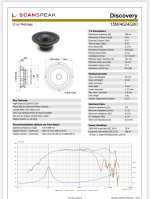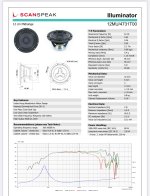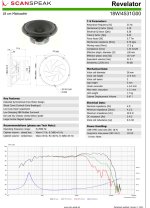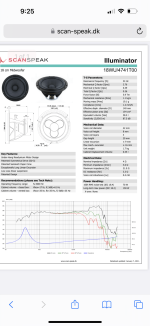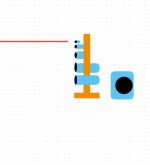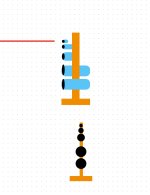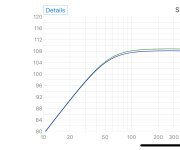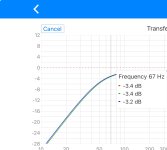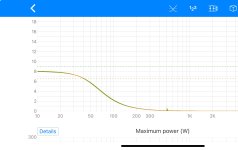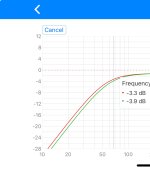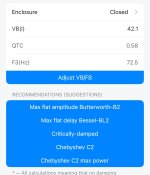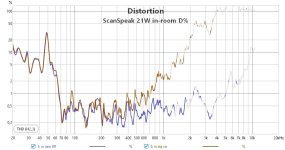A negative impedance is another way of dealing with non flat impedance in a driver. Nelson Pass has used the approach with Festerex full range drivers. They sounded quite good in his listening room.
In diy anything goes. You can believe what you believe.
In a loudspeaker project to protect your investment, your time and sanity it’s important to have certainty that
A . You can build your project
B. That you will finish it in a reasonable time frame
C. That is will reach your expectations.
As l mentioned early on in diy the answer(s) we are looking for we can be completely oblivious too. What is the difference between diy and a commercial consumer system. They do a more trial and error with mock ups. They test and listen until it works properly before committing to a design. Then they refine it in the final voicing of the tonal integration of the drivers.
In my experience in diy we sometimes spend way too much time over thinking a project and not nearly enough time testing and listening to ensure it’s working properly. We want it perfect at the outset. That’s crazy in the loudspeaker business.
In diy anything goes. You can believe what you believe.
In a loudspeaker project to protect your investment, your time and sanity it’s important to have certainty that
A . You can build your project
B. That you will finish it in a reasonable time frame
C. That is will reach your expectations.
As l mentioned early on in diy the answer(s) we are looking for we can be completely oblivious too. What is the difference between diy and a commercial consumer system. They do a more trial and error with mock ups. They test and listen until it works properly before committing to a design. Then they refine it in the final voicing of the tonal integration of the drivers.
In my experience in diy we sometimes spend way too much time over thinking a project and not nearly enough time testing and listening to ensure it’s working properly. We want it perfect at the outset. That’s crazy in the loudspeaker business.
Last edited:
Sorry for thread hogging again. Sometimes l get over enthusiastic in the diy spaces when l see a simple but elegant solution. Eek 😦
Just my 2 cents worth.
We have so much freedom and so many possibilities. But so little time…
Edit. My previous post is not meant to be condescending or a high school tutorial. But after collaborating on numerous diy loudspeaker projects remotely those 3 essentials are what it boils down to.
Others here have reiterated this in different ways.
Just my 2 cents worth.
We have so much freedom and so many possibilities. But so little time…
Edit. My previous post is not meant to be condescending or a high school tutorial. But after collaborating on numerous diy loudspeaker projects remotely those 3 essentials are what it boils down to.
Others here have reiterated this in different ways.
Last edited:
Hmm.
For most of the thing you depict i would rather focus on your room than on loudspeakers but... you can't expect to have same mix of Early Reflection in domestical room than in a (huge) theater ( it's dimension related and/or geometry/shape related, as well as a mix of absorbing material/redirecting of wavefront).
And don't expect 'room correction' to be of any help regarding this, Early Reflection can only be treated by physical treatment ( acoustic treatment).
You could try to implement an RFZ but... in a domestical room for long ER ( >20ms with -20db attenuation)... it's even difficult in 'large' dedicated control room... and by large i mean bigger than 60m2 or in the 200m3 vicinity...
Imo best bet is with narrow radiating loudspeaker ( waveguide/horn) and implementing an RFZ.
Iow the inverse of what you are trying to achieve.
One big restriction I forgot to mention: My wife forbade most of the room treatment options. It's an open space, so she is already bearing with my "ugly" things.... This really leaves me no option for the huge wall mirror behind front speakers giving me the big mouth phenomenon.
Probably too late to answer and you figured it out, but for the record:
It's almost like Forte kit except the tweeter, mid and the crossover(none in mine). They use good tweeters, and back then offered the revelator 99000 tweeter which I should have accepted. Forte didn't exist at the time but they reused the design for mine into Forte. Forte used to have ATC mids, but had to switch to Volt as it is now.
Hmm. I’ve had a look at your drivers and your comments.
Your tweeter is definitely out of date.
I would not change everything at once so l suggest keep using the ATC mid for now.
Exactly. Later on, I realized this, regretted, and looked for a replacement option without touching the box - unfortunately none. I intentionally chose it for ferrofluid because I was clueless, thinking it would give me better driver durability. I didn't need any more durability and I should have taken performance instead...
On the bass that could be your using the SVS sub. You are obviously reaching for more bass and lower because you’re using the SVS.
Probably not more but better. It seems to go low enough, and measurement shows -6dB around 20 - 25Hz. But subjectively, the big Scanspeak woofer(actually same size of 13") seems to sound more natural and open.
However, I leave this bass to the next project of side-firing passive subwoofer module to place behind the woofer module we are talking about now. For now, I am aiming at this dual or quad woofer module reaching reasonably low frequency to work with the SVS.
Is the Volt 2500.1 in a sealed enclosure?
It's the Wilmslow-designed bass reflex with a front port, but I forgot most of the details other than the70 liter volume...
Okay l fed it all into the super computer
This is what l suggest :
Tack it in two stages. The reason is it you change everything it might confuse you.
Yes. I think I mentioned that building will start with the tweeter module to act in place of the 9500 in my Wilmslow, sitting on top of the box. I am looking at 3-D printing options to build a cylinder for this one, and also another for the Satori mid if I end up choosing it or at least deciding to experiment with it. Maybe I can add only the front baffles if needed after building the cylinders.
However, steps from Satori, it needs changes in my DSP/electronics, so timing is uncertain. I am looking into turning my HTP-1 processor to just a pass-through 8-ch DAC/volume and move the processing to my Mac mini. This depends on successfully creating a aggregate audio output device on macOS
grouping this HDMI-input processor and some other USB DACs. I lose 4 channels by changing the usage of the processor, so need to add back the lost channels with USB DACs. I am concerned about the mismatch in clocking, and it may eventually fail, forcing me to buy not-so-expensive pro gears. I am also trying to sell the processor, but no luck so far. 🙁
The mid treble step
Then later the bass step
The tweeter
https://www.scan-speak.dk/datasheet/pdf/d3004-606200.pdf
Your current tweeter has fero fluid. That idea went out of fashion a long time ago. This is a thin carbon tweeter of varying thickness. I think it’s a better material (close to beryllium) for high frequencies. Mount the tweeter like the B&W 801 D4 atop the mid dome. This should make the highs more airy.
Oh, I didn't know Scanspeak makes textreme tweeters. I went to the T.H.E. Show SoCal earlier this month, and Gryphon's textreme-woofer based system impressed my friend and me, so textreme also seems promising unlike older carbon-fiber based ones. The small diameter is a good plus, though I am not sure about its sound agreeing with my subjective taste. In this step, I am looking at only textile dome tweeters, but I think I can try other types later by building more cylinders matching the chosen test subjects. ;=)
Midrange
Retain the ATC dome for now. Place it in a tube with a round over if possible. Keep it well above the bass enclosure.
My POR is not using this, as I want to retain my Wilmslow as is. Maybe later I realize I can't sell this, and do something about it... Maybe I will use them as my rear surrounds(what a luxury and/or waste!) and try to sell my Magges instead...
The crossover
Take 7 individual measurements around your listening position of the tweeter and then the dome mid.
Then average them and make a driver correction curve for each driver.
Apply the correction and set about creating your FIR crossover filters
Of the mid kid still isn’t doing it for you my suggestion is to try the Purifi 6.5 in midrange. Don’t search for anything else. This is likely the best mid on the planet.
I will keep the steps in mind. I am afraid there is a WAF issue with the Purifi drivers... lol.
I think the larger radiating area is likely to project better for HiFi listeners as apposed to near field monitors
Woofer step.
I would keep your existing Woofer ams used in the recommended vented enclosure. Driven actively it will perform better. If your running it sealed stop doing this. Use the 40L enclosure.
Assess the bass ouput. If you need more bass add a side 12 inch Volt woofer.
Yep. After seeing advices from Alex and others, side-firing passive stereo subwoofers sound good to me. I was thinking of 13"/15" Scanspeak woofers, and some 15" professional woofers like JBL, Eminence, etc, as well as Volt 12" or 15". The big WAF advantage is that the big "ugly" drivers can be kept out of sight by its placement/orientation and the grill! 😉
One reservation I have with most of these drivers is the longevity of the surrounds. With my shitty hand skill, I don't want to do the reconing myself, and having others do it is a big hassle...
Last edited:
Okay l think l get it.
Then we can rollback and calibrate around your situation.
So from a project standpoint you want to
move the crossover dsp to your Mac mini.
You want to develop a new mid bass mid tweeter set of drivers.
Then place a larger side firing woofer behind the main loudspeaker.
I don’t necessarily see a loss of channel count as a limitation here.
Given the above you have some options and a lot of helpful people here to help crunch the design details
1. Main loudspeaker
Design as a passive system
Bi amp to the new bass module
Use the Mac mini for room correction
2. Main loudspeaker
Design as bi amp from bass woofers to the
mid and tweeter which are passive
The bass woofers operate down to their
lower limit until the new bass module
is ready
So overall it’s at most a triamp only
situation
It’s actually not difficult to design a competent passive system. You can always go fully active at a later stage. I think you have more value on running Dirac on the Mac mini in the short term.
Budget
Let’s assume you’re looking at a 3 way system. What realistically do you want to spend on the new main loudspeakers?
Then we can rollback and calibrate around your situation.
So from a project standpoint you want to
move the crossover dsp to your Mac mini.
You want to develop a new mid bass mid tweeter set of drivers.
Then place a larger side firing woofer behind the main loudspeaker.
I don’t necessarily see a loss of channel count as a limitation here.
Given the above you have some options and a lot of helpful people here to help crunch the design details
1. Main loudspeaker
Design as a passive system
Bi amp to the new bass module
Use the Mac mini for room correction
2. Main loudspeaker
Design as bi amp from bass woofers to the
mid and tweeter which are passive
The bass woofers operate down to their
lower limit until the new bass module
is ready
So overall it’s at most a triamp only
situation
It’s actually not difficult to design a competent passive system. You can always go fully active at a later stage. I think you have more value on running Dirac on the Mac mini in the short term.
Budget
Let’s assume you’re looking at a 3 way system. What realistically do you want to spend on the new main loudspeakers?
Looking at the high level design this is a narrow baffle tower with two or more 8 inch woofers, an upper mid dome and a dome tweeter.
There are a few decisions that need to be accepted here. If you plan to use 8 inch woofer then yes the Satori dome mid is necessary for a 3-4 khertz crossover to the tweeter.
When ready your side firing bass module will cover frequencies below 100 hertz. This will be actively crossed over to the main module.
The main loudspeaker will then become a full frequency range mid bass system.
Let’s assume you have defined your budget. I recommend you stick with one brand to ensure compatibility of the drivers and to streamline the project. My suggestion to SB Acoustics as they have a good assortment of drivers in different cone materials.
There are a few decisions that need to be accepted here. If you plan to use 8 inch woofer then yes the Satori dome mid is necessary for a 3-4 khertz crossover to the tweeter.
When ready your side firing bass module will cover frequencies below 100 hertz. This will be actively crossed over to the main module.
The main loudspeaker will then become a full frequency range mid bass system.
Let’s assume you have defined your budget. I recommend you stick with one brand to ensure compatibility of the drivers and to streamline the project. My suggestion to SB Acoustics as they have a good assortment of drivers in different cone materials.
Do you really think it is important to stick with a single brand? I have never found any real benefit to this. I have used a lot of SBA drivers in my speakers because they were available, and offered good performance for the price. But how would an SB midrange "know" if it was mated up to a Seas tweeter and a Wavecor woofer?I recommend you stick with one brand to ensure compatibility of the drivers and to streamline the project.
Looking at some examples of existing Satori designs see the attached below
https://sbacoustics.com/wp-content/uploads/2022/11/Sasandu-User-Manual.pdf
The main difference is they are using a Satori 6.5 in mid from 480-2800 hertz. So we have the same chestnut of why they did this?
Well the 60.5mm mid dome is a new product. But you have to believe there are good reasons for the 6.5” Satori mid. The of axis stuff is really good too.
However, you may not be prepared for the overall enclosure size.
43” x 9” x 24”.
That’s a fairly large enclosure.
Removing the 6.5 in mid makes the enclosure less in volume but it would become a stand mount profile or less deep.
The other possibility is to design it as a integrated system at the outset.
Just continue to use the SVS sub until your ready.
If you accept this path the group can go to work on it . It might look like this
29 mm Satori tweeter 4000 -20,000
2 1/2 Satori mid 800-4000 hertz
8 inch mid bass 80 - 800 hertz
13 inch side firing woofer
It would certainly be an interesting exercise and probably more cost effective.
https://sbacoustics.com/wp-content/uploads/2022/11/Sasandu-User-Manual.pdf
The main difference is they are using a Satori 6.5 in mid from 480-2800 hertz. So we have the same chestnut of why they did this?
Well the 60.5mm mid dome is a new product. But you have to believe there are good reasons for the 6.5” Satori mid. The of axis stuff is really good too.
However, you may not be prepared for the overall enclosure size.
43” x 9” x 24”.
That’s a fairly large enclosure.
Removing the 6.5 in mid makes the enclosure less in volume but it would become a stand mount profile or less deep.
The other possibility is to design it as a integrated system at the outset.
Just continue to use the SVS sub until your ready.
If you accept this path the group can go to work on it . It might look like this
29 mm Satori tweeter 4000 -20,000
2 1/2 Satori mid 800-4000 hertz
8 inch mid bass 80 - 800 hertz
13 inch side firing woofer
It would certainly be an interesting exercise and probably more cost effective.
Attachments
Do you really think it is important to stick with a single brand? I have never found any real benefit to this. I have used a lot of SBA drivers in my speakers because they were available, and offered good performance for the price. But how would an SB midrange "know" if it was mated up to a Seas tweeter and a Wavecor woofer?
That’s a good point. But SB comparing their families of drivers across aluminium, ceramic coated aluminium, paper, paper blends, textreme (carbon ply), beryllium. Textile domes
It shortens up the list of endless possibilities.
With a realistic budget it makes it easier to work with some defined choices
I just think Scan and Seas would end up being an expensive situation overall. SB are very good value and they are designed in Denmark
Okay l think l get it.
Then we can rollback and calibrate around your situation.
So from a project standpoint you want to
move the crossover dsp to your Mac mini.
You want to develop a new mid bass mid tweeter set of drivers.
Then place a larger side firing woofer behind the main loudspeaker.
I'd say it's a subwoofer though it's not an ELF design, and would be a next project whose time line is quite apart from this project.
I don’t necessarily see a loss of channel count as a limitation here.
Not sound loss, just expensive to get more DACs...
My POR is a 4-way active system with tweeter + midhigh + midbass + woofers.Given the above you have some options and a lot of helpful people here to help crunch the design details
1. Main loudspeaker
Design as a passive system
Bi amp to the new bass module
This POR 4-way system is fully active.
Use the Mac mini for room correction
And also crossover, file playback, bd/dvd playback, etc.
2. Main loudspeaker
Design as bi amp from bass woofers to the
mid and tweeter which are passive
The bass woofers operate down to their
lower limit until the new bass module
is ready
The 'bass' module covers down to some trade-off frequency(between volume and subjective performance/quality), below which will be covered by the SVS for now, and later by the side-firing subwoofer module.
So overall it’s at most a triamp only
situation
Quad ;=)
It’s actually not difficult to design a competent passive system. You can always go fully active at a later stage. I think you have more value on running Dirac on the Mac mini in the short term.
I think my arsenals of tools and gears make going active much easier than passive. I already have 15 channels of amplifications(3 stereo + 1 9-channel). DACs need to be added.
Budget
Let’s assume you’re looking at a 3 way system. What realistically do you want to spend on the new main loudspeakers?
I don't have a concrete number, but driver cost below $2K for now? Things have become really expensive recently, and I miss the old days,lol.
First of all, sorry for my wrong post. The Wilmslow kit similar to mine is Encore, not Forte.
I can't answer or comment on others, but I was trying to get an idea what kind of volume or dimension for the bass box, so this is a welcomed, but also alarming number. Using with the SVS or future pass subwoofer module, I was also leaning toward a sealed enclosure. Is this volume for sealed or vented?
I guess it can be a bit taller, but that is almost twice as deep as mine right now. In order to leave some room for 15" side-firing subwoofer behind it, I guess it can't be much deeper than current 340mm(13.5"?)...
I am willing to compromise on the lowest bass to reduce the volume. But half of me is drooling on this 4-way one being as complete in itself as possible. Hard choice to make.
So, what I thought I have been saying here is:
21mm Scanspeak tweeter above 4000 ~ 5000
60mm Satori midhigh from (700 ~ 850) to (4000 ~ 5000)
170mm Scanspeak midbass from (150 ~ 250) to (700 ~ 850)
200mm x2 or x4, or 170mm x4 woofers from (40 ~ 70) to (150 ~ 250)
330mm SVS subwoofer below (40 ~ 70)
Looking at some examples of existing Satori designs see the attached below
https://sbacoustics.com/wp-content/uploads/2022/11/Sasandu-User-Manual.pdf
The main difference is they are using a Satori 6.5 in mid from 480-2800 hertz. So we have the same chestnut of why they did this?
Well the 60.5mm mid dome is a new product. But you have to believe there are good reasons for the 6.5” Satori mid. The of axis stuff is really good too.
However, you may not be prepared for the overall enclosure size.
43” x 9” x 24”.
That’s a fairly large enclosure.
Removing the 6.5 in mid makes the enclosure less in volume but it would become a stand mount profile or less deep.
The other possibility is to design it as a integrated system at the outset.
Just continue to use the SVS sub until your ready.
If you accept this path the group can go to work on it . It might look like this
29 mm Satori tweeter 4000 -20,000
2 1/2 Satori mid 800-4000 hertz
8 inch mid bass 80 - 800 hertz
13 inch side firing woofer
It would certainly be an interesting exercise and probably more cost effective.
I can't answer or comment on others, but I was trying to get an idea what kind of volume or dimension for the bass box, so this is a welcomed, but also alarming number. Using with the SVS or future pass subwoofer module, I was also leaning toward a sealed enclosure. Is this volume for sealed or vented?
I guess it can be a bit taller, but that is almost twice as deep as mine right now. In order to leave some room for 15" side-firing subwoofer behind it, I guess it can't be much deeper than current 340mm(13.5"?)...
I am willing to compromise on the lowest bass to reduce the volume. But half of me is drooling on this 4-way one being as complete in itself as possible. Hard choice to make.
So, what I thought I have been saying here is:
21mm Scanspeak tweeter above 4000 ~ 5000
60mm Satori midhigh from (700 ~ 850) to (4000 ~ 5000)
170mm Scanspeak midbass from (150 ~ 250) to (700 ~ 850)
200mm x2 or x4, or 170mm x4 woofers from (40 ~ 70) to (150 ~ 250)
330mm SVS subwoofer below (40 ~ 70)
http://www.troelsgravesen.dk/26W-4558T00.htm#12_subwoofer
Have a read through this article and it will inform you of most of your questions
Have a read through this article and it will inform you of most of your questions
http://www.troelsgravesen.dk/26W-4558T00.htm#12_subwoofer
About the mid woofer l found Scan speak have quite a good range of mid woofers.
The lower the crossover point the more linear Xmax you need.
There are two potential candidates
These are on the small size sealed if you refer to the data sheet and they are long excursion.
Technically if the main loudspeaker is disassociated from the lows then the crossover point needs to be under 100 herz.
But if your sub is near to the main then you have some flexibility with the crossover point like 75-150 hertz.
Because these are by definition mid woofers and quality Scan drivers you probably could run it up to 800 hertz.
You might get away with just one.
Otherwise my initial suggestion is 75-250 hertz.
If this is the case then you have a variety of mid range drivers in the Scan range to select from.
Because you are breaking up the low to upper mid range into different bands the rules on baffle step are not 100% certain. This is where you loudspeaker design simulator will be very useful.
In terms of mid range drivers it might be worth looking at the 12M or the 15M models. You can place it further up near the 60mm dome away from any reflective interference from the mid bass driver. The wavelength at the 250 hertz crossover is over one metre so you can place it near the Sartori dome.
My thoughts in a sketch
If this is what you had in mind cool.
You have lots of smart people here to offer insights into how to organise it all.
Remember this is diy and you’re going to have to get hands on with your tools. That is the fun part!
Edit l have attached the dual mid bass sketch. Dave Wilson is looking down at your project.
About the mid woofer l found Scan speak have quite a good range of mid woofers.
The lower the crossover point the more linear Xmax you need.
There are two potential candidates
These are on the small size sealed if you refer to the data sheet and they are long excursion.
Technically if the main loudspeaker is disassociated from the lows then the crossover point needs to be under 100 herz.
But if your sub is near to the main then you have some flexibility with the crossover point like 75-150 hertz.
Because these are by definition mid woofers and quality Scan drivers you probably could run it up to 800 hertz.
You might get away with just one.
Otherwise my initial suggestion is 75-250 hertz.
If this is the case then you have a variety of mid range drivers in the Scan range to select from.
Because you are breaking up the low to upper mid range into different bands the rules on baffle step are not 100% certain. This is where you loudspeaker design simulator will be very useful.
In terms of mid range drivers it might be worth looking at the 12M or the 15M models. You can place it further up near the 60mm dome away from any reflective interference from the mid bass driver. The wavelength at the 250 hertz crossover is over one metre so you can place it near the Sartori dome.
My thoughts in a sketch
If this is what you had in mind cool.
You have lots of smart people here to offer insights into how to organise it all.
Remember this is diy and you’re going to have to get hands on with your tools. That is the fun part!
Edit l have attached the dual mid bass sketch. Dave Wilson is looking down at your project.
Attachments
Last edited:
I just completed my first 3-way, which is also my first active speaker (second center channel) using a Hypex plate amp and similar components to my 2-way main speakers. There are a dozen nice things about using DSP to do the crossover, but at the end of the day I can honestly say it sounds just as good as my main, passively crossed speakers. Maybe I did something wrong, but for me in the future I'll be doing active mostly for the convenience and feature selection than because I have heard how much better active speakers are.
I tend to agree.
Well the latest iteration does indeed tool like an Anthony Gallo design. I actually heard one of these a long time back and it sounded very good.
Well the latest iteration does indeed tool like an Anthony Gallo design. I actually heard one of these a long time back and it sounded very good.
I had a look at the simulator for both the ScanSpeak mid bass woofers. The illuminator is the preferred driver as two of these only occupies 28L in a sealed enclosure. The Revalator 40L for a pair of drivers. . It also has a larger linear Xmax of 9mm. No doubt it costs more than the Revalator. The sensitivity is about 90 db for each of the models.
They are both rated at 4 ohm impedance. Depending on the baffle step simulation you might be able to run these is series electrical connection.
Either way with two woofers the output will increase by +3 db but the cone excursion will reduce to 1/4 of a single driver. If you can swing it get four of these babies because it will be cleaner subjectively.
Looking back at your driver line up you have a single Scan speak 170mm driver from 250-800 hertz.
Technically you may get a better integration with with of the 15M or 12M pure midrange drivers in my attachments . It’s simply that they are smaller and have lower mass cone than the 170mm driver.. The Satori 60mm dome has a low mass diaphragm so think about that. You can also place it closer to the mid dome.
All these points add up to a smoother more seamless transition at 800 hertz.
They are both rated at 4 ohm impedance. Depending on the baffle step simulation you might be able to run these is series electrical connection.
Either way with two woofers the output will increase by +3 db but the cone excursion will reduce to 1/4 of a single driver. If you can swing it get four of these babies because it will be cleaner subjectively.
Looking back at your driver line up you have a single Scan speak 170mm driver from 250-800 hertz.
Technically you may get a better integration with with of the 15M or 12M pure midrange drivers in my attachments . It’s simply that they are smaller and have lower mass cone than the 170mm driver.. The Satori 60mm dome has a low mass diaphragm so think about that. You can also place it closer to the mid dome.
All these points add up to a smoother more seamless transition at 800 hertz.
Attachments
Last edited:
Looking at point 1 can l recommend it might be prudent to build for example the well engineered low frequency project detailed by Troels then test your cylinders on too the Wimslow enclosure1. Probably not more but better. It seems to go low enough, and measurement shows -6dB around 20 - 25Hz. But subjectively, the big Scanspeak woofer(actually same size of 13") seems to sound more natural and open.
However, I leave this bass to the next project of side-firing passive subwoofer module to place behind the woofer.
Yep. After seeing advices from Alex and others, side-firing passive stereo subwoofers sound good to me. I was thinking of 13"/15" Scanspeak woofers, and some 15" professional woofers like JBL, Eminence, etc, as well as Volt 12" or 15". The big WAF advantage is that the big "ugly" drivers can be kept out of sight by its placement/orientation and the grill! 😉
One reservation I have with most of these drivers is the longevity of the surrounds. With my shitty hand skill, I don't want to do the reconing myself, and having others do it is a big hassle...
The reasoning for this order of action is that your basing your decision on the 13 inch scan woofer listening to someone else’s system in a different setting if l am not mistaken.
Because you are familiar with the Wimslow bass this would be a far more logical step to appraise the difference in a different sub.
Therefore it’s seems of move value to build the Troels music sub for example before embarking on the dual 8 inch woofer enclosure.
Otherwise your throwing all the balls up the air by moving to a new sealed bass system and an unknown new sub.
At least Troels had provided full disclosure and instructions on how to go about issuing his design for high fidelity music.
- Home
- Loudspeakers
- Multi-Way
- 4-way instead of 3-way?


